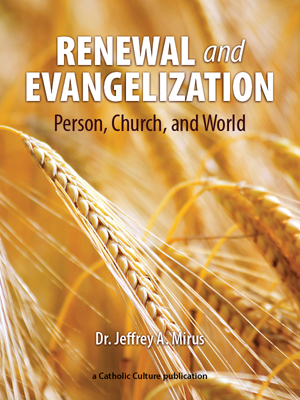What Does Summorum Pontificum Say?
By Dr. Jeff Mirus ( bio - articles - email ) | Jul 13, 2007
Pope Benedict XVI’s Motu Proprio Summorum Pontficum consists of a general introduction followed by a series of prescriptions for addressing the use throughout the Church of the Roman Missal of 1962.
In this blog entry, I simply summarize the document and what it decrees. For an explanation of why Benedict ruled as he did, see Why Was Summorum Pontificum Issued?. For a consideration of the possible consequences of the Motu Proprio, see Summorum Pontificum: What Will Its Impact Be?.
The introduction to Summorum Pontificum begins by asserting the “constant concern of supreme pontiffs to ensure that the Church of Christ offers a worthy ritual to the Divine Majesty” and the perennial necessity that each particular Church “must concur with the universal Church” not only in doctrine and sacraments, but also in the “usages universally accepted by uninterrupted apostolic tradition”. This is essential “to transmit the integrity of the faith, because the Church's law of prayer corresponds to her law of faith.”
Next the document recounts the history of this pontifical solicitude with respect to the Roman rite, including the many efforts to reform and update this rite, starting with the Council of Trent and Pope St. Pius V, and continuing in recent times through the efforts of six other popes, culminating in the 1962 Missal of Blessed John XXIII. The motu proprio then refers to the desire expressed at Vatican II for further renewal and adaptation to the needs of our time, which led to the “reformed and partly renewed” liturgical books promulgated by Paul VI in 1970, in particular the Roman Missal which has been further amended up to the third typical edition under John Paul II.
Turning to the matter at hand, Benedict notes that, after the 1970 Missal was issued, “in some regions, no small numbers of faithful adhered and continue to adhere with great love and affection to the earlier liturgical forms.” This led to an indult by the Congregation for Divine Worship in 1984 granting permission to use the Missal of 1962, followed by the Motu Proprio Ecclesia Dei in 1988, by which John Paul II “exhorted bishops to make generous use of this power in favor of all the faithful who so desired.”
“Following the insistent prayers of these faithful”, Benedict then makes new provisions in the following twelve articles:
- While the Missal of Paul VI is the “ordinary expression of the ‘Lex orandi’ (Law of prayer) of the Catholic Church, the Roman Missal of Blessed John XXIII is to be considered as an “extraordinary expression of that same ‘Lex orandi’, and must be given due honour for its venerable and ancient usage.” Therefore, it is permissible to use the 1962 Missal, which in fact was “never abrogated”, as an “extraordinary form of the Liturgy of the Church”, under the following conditions:
- For Masses celebrated without the people (private Masses), each Catholic priest of the Latin rite may use either the 1962 Missal or the 1970 Missal, without permission, on any day with the exception of the Easter Triduum.
- Communities of consecrated and apostolic life may use the 1962 Missal for community celebration, but if they wish to do so “often, habitually or permanently”, the decision must be taken by the Superiors Major.
- The private Masses mentioned in number 2 may also be attended by faithful “who, of their own free will, ask to be admitted.”
- In parishes, “where there is a stable group of faithful who adhere to the earlier liturgical tradition”, the pastor should make provision for them to celebrate Mass according to the 1962 Missal. Such celebration may take place on “working days”, while on Sundays and feast days “one such celebration may also be held.” For faithful and priests who request it, the pastor should also allow celebrations according to the 1962 Missal for special events such as weddings, funerals or occasional celebrations such as pilgrimages. Priests who use the 1962 Missal must be qualified to do so.
- When the 1962 Missal is used, the readings may be given in the vernacular.
- A group of lay faithful which desires the 1962 Missal but does not receive “satisfaction from the pastor” should inform the diocesan bishop, and the bishop “is strongly requested” to satisfy them. If “he cannot arrange for such a celebration”, the matter should be referred to the Pontifical Commission “Ecclesia Dei”.
- Similarly, a bishop who wishes to satisfy such requests but is unable to do so, may refer the problem to the Ecclesia Dei Commission for assistance.
- The pastor may also grant the use of the earlier ritual for the sacraments of Baptism, Marriage, Penance and Anointing of the Sick, if “the good of souls would seem to require it”. Similarly, Ordinaries may use the earlier Roman Pontifical for the celebration of Confirmation, for the same reason.
- The Ordinary may erect a personal parish or appoint a chaplain for “celebrations following the ancient form of the Roman rite”.
- The Pontifical Commission “Ecclesia Dei” continues to exercise its function, with such duties as the Roman Pontiff may wish to assign to it.
- The Ecclesia Dei Commission “will exercise the authority of the Holy See, supervising the observance and application of these dispositions.”
Finally, the Pope orders that these provisions are to be observed beginning on September 14, 2007.
All comments are moderated. To lighten our editing burden, only current donors are allowed to Sound Off. If you are a current donor, log in to see the comment form; otherwise please support our work, and Sound Off!









